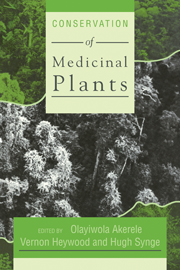Book contents
- Frontmatter
- Contents
- Contributors
- Preface
- Acknowledgements
- The Chiang Mai Declaration
- Introduction
- The Issue of Medicinal Plants
- Science, Industry and Medicinal Plants
- Techniques to Conserve Medicinal Plants
- Policies to Conserve Medicinal Plants
- 15 Policies and Organisation for Medicinal Plant Conservation in Sri Lanka
- 16 Experience in the Conservation of Medicinal Plants in Sri Lanka
- 17 The Conservation of Medicinal Plants Used in Primary Health Care in Thailand
- 18 Medicinal Plants and the Law
- 19 Let's Stop Talking to Ourselves: The Need for Public Awareness
- 20 Germplasm, Genetic Erosion and the Conservation of Indonesian Medicinal Plants
- Experiences from Programmes to Conserve Medicinal Plants
15 - Policies and Organisation for Medicinal Plant Conservation in Sri Lanka
Published online by Cambridge University Press: 07 September 2010
- Frontmatter
- Contents
- Contributors
- Preface
- Acknowledgements
- The Chiang Mai Declaration
- Introduction
- The Issue of Medicinal Plants
- Science, Industry and Medicinal Plants
- Techniques to Conserve Medicinal Plants
- Policies to Conserve Medicinal Plants
- 15 Policies and Organisation for Medicinal Plant Conservation in Sri Lanka
- 16 Experience in the Conservation of Medicinal Plants in Sri Lanka
- 17 The Conservation of Medicinal Plants Used in Primary Health Care in Thailand
- 18 Medicinal Plants and the Law
- 19 Let's Stop Talking to Ourselves: The Need for Public Awareness
- 20 Germplasm, Genetic Erosion and the Conservation of Indonesian Medicinal Plants
- Experiences from Programmes to Conserve Medicinal Plants
Summary
The conservation of nature and natural resources in Sri Lanka is as old as her culture which goes back 2500 years. The pastoral way of life centering round an agricultural economy, enriched by the Buddhist aversion to the taking of any form of life, gave rise to a unique society which lived in perfect harmony with the environment.
Along with the original settlers from India, who brought their rudimentary agricultural practices, came also the ancient Science of Ayurveda, which means “the science of living”. The Lord Buddha himself received Ayurveda treatment and exhorted the value of it. This example was taken up readily and seriously by the clergy, who became excellent exponents of this science. In turn, through the respect the people had for the clergy, they placed their trust in this form of medicine.
The temples became the respositories of the ancient texts on Ayurveda – the “Samhitas” and “Niganduwas” – which contributed in large measure to their preservation and subsequent survival during 400 years of foreign rule.
During those 400 years, the conservation of nature fell into disarray. Only during the past few decades can it be said that there has been a serious attempt at revival.
In this respect the present Government in Sri Lanka has taken numerous progressive steps towards inculcating in the minds of the people a strong pride in their natural heritage. His Excellency the President himself has led the field in doing so. Indeed the responsibility of the people has been enshrined in the present Constitution of Sri Lanka thus: “It is the duty of every person in Sri Lanka to protect nature and conserve its riches”.
- Type
- Chapter
- Information
- Conservation of Medicinal Plants , pp. 241 - 248Publisher: Cambridge University PressPrint publication year: 1991
- 1
- Cited by



